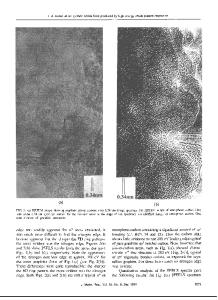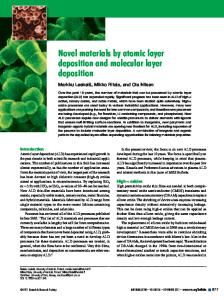Composite Materials Produced by Photocatalytic Underpotential Deposition
- PDF / 107,769 Bytes
- 1 Pages / 612 x 792 pts (letter) Page_size
- 26 Downloads / 474 Views
Tightly Focused Femtosecond Laser Pulses Facilitate Processing of Bulk Glass with Nanojoule Energies Processing optically transparent materials with laser pulses presents a promising means of micromachining. Focusing a
86
femtosecond laser pulse beneath the surface of a transparent material causes localized and nonlinear energy absorption at the focal volume. This absorption, in turn, leads to optical breakdown and permanent structural changes in the immediate vicinity of the focus while leaving the surface unaffected. To date, however, only amplified, kilohertz repetition-rate femtosecond lasers have had the power necessary to micromachine glass, severely limiting the maximum processing speed and dramatically increasing the cost of the laser system. As reported in the January 15 issue of Optics Letters, a research group from the Department of Physics at Harvard University has demonstrated that optical breakdown can occur with as little as 5 nJ of laser pulse energy when a 1.4 NA (numerical aperture) lens is used to focus the pulses. This energy is in the range of modern femtosecond laser oscillators, allowing megahertz repetition-rate unamplified lasers to enter the micromachining arena. The energy threshold for structural alteration as a function of NA was first determined. A 100-fs pump pulse from a Ti:sapphire laser system irradiates a borosilicate glass sample. The laser pulse was focused beneath the surface, using a variety of lenses whose NA ranges from 0.25 to 1.4. A HeNe laser is used to probe the pumped volume of the sample. When optical breakdown occurs, HeNe light scattered by the structural alteration is detected, allowing the researchers to determine the threshold energy versus NA. With a single 10-nJ, 100-fs laser pulse focused by a 1.4 NA lens, a cylindrical structure 0.5 µm in diameter and 2 µm in height was created. Structures with larger diameters were obtained with multiple pulses incident on the same spot in the sample at a high repetition rate. The diameter of these cylinders was found to be proportional to (number of pulses)0.25. A third experiment demonstrated that single-mode optical waveguides could be made with the same techniques. Using 5-nJ, 100-fs pulses incident at a 25-MHz repetition rate, an optical waveguide can be written by translating the sample perpendicular to the incident direction of the laser pulse. This waveguide has a near-Gaussian output profile at visible wavelengths. The change in refractive index is about 3 × 10-4 from core to rim of the laser-written waveguide. The straightforwardness of the laser requirements makes structural manipulation of transparent media on the micrometer scale practical. Already the researchers have demonstrated the direct writing of optical waveguides in bulk glass. JUNE LAU
Composite Materials Produced by Photocatalytic Underpotential Deposition The preparation of a TiO2/MSe (M = Cd and Pb) composite material by TiO2-based photocatalysis was recently reported by the research group of Krishnan Rajeshwar, a professor in the Department of Ch
Data Loading...










